Long-nosed Tangle-veined Flies need to be accurate on the wing when hovering to line up the long proboscis to suck nectar from tubular flowers. These amazing flies are interesting to watch and tricky to photograph.
Tangle-veined flies (Nemestrinidae) occur in many parts of the world with about 300 species in 34 genera. The Field Guide to Insects of South Africa states that there are “48 species of these rather rare flies known from the region”. It also says that little is known about the larval stages of the species in the region, adding that elsewhere in Africa they are known to be quite common parasites of locusts. Wikipedia notes that the larvae are endoparasitoids of either grasshoppers of scarab beetles and that some are considered important in the control of grasshopper populations.

A Tangle-veined fly at rest on a the leaf of a brinjal plant in the vegetable garden
I seldom see these flies at rest, but when I eventually did, I could see that they do not roll up the long proboscis as a butterfly does, but when at rest they tuck it back between their legs. In some species of Tangle-veined Flies the proboscis is absent. At the opposite extreme, such as in the Mega-proboscid Tangle-veined Fly, which occurs in the southern region of the Western Cape (South Africa), the proboscis – specially adapted to pollinating long-tubed flowers – can be an impressive 70 mm in length relative to a wingspan of 40-45 mm.

This Tangled-vein Fly is settled on a leaf with its proboscis tucked back between the legs. The proboscis is about the same length as its body. The orange background is formed by flowers of the Wild Dagga (Leonotis leonurus)
The Tangled-vein Fly is at its most impressive when feeding on the wing. While hovering it lines up a flower in order to be able to insert the long proboscis into the tube. It continues to hover while it sucks up the nectar. There is a sucking pump-like mechanism in the head to enable it to do this.

A Tangle-winged Fly approaching a flower
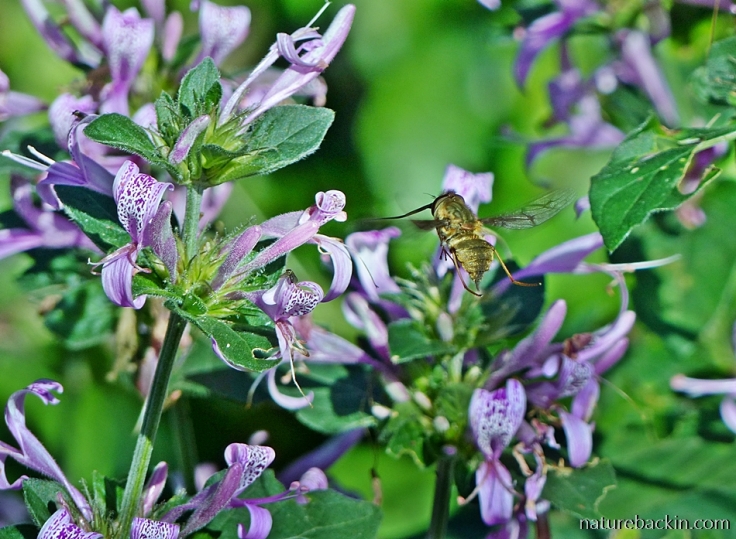
The fly carefully lines up its proboscis before inserting it down the mouth of the flower’s tube

Another successful alignment
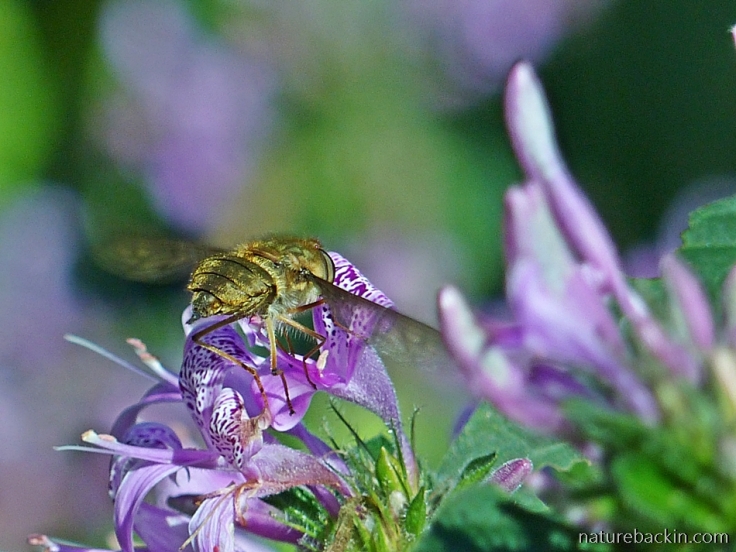
The Tangle-veined Fly continues to hover while sucking up nectar from a flower of a Ribbon Bush (Hypoestes aristata)
Although I know little about these flies, I would hazard a guess that the flies photographed at the Ribbon Bush in our garden might be a Bent-wing Tangle-veined Fly (Stenobasipteron wiedemanni), a species found in the eastern part of South Africa frequenting forests and forest margins.

A Tangle-veined Fly flying with its long proboscis dangling before lining up at another flower for another feed
Tangle-veined Flies are said to buzz loudly while hovering over a flower. I can’t say that I have particularly focused on that – perhaps it is something I have taken for granted without paying proper attention.
I have mostly noticed these flies nectaring when the Ribbon Bushes are flowering during autumn and winter, but I have also seen long-tongued flies in the herb garden when the Basil is in flower. It is possible that this fly (below), seen in silhouette with its fast-moving wings ablur, is another species.
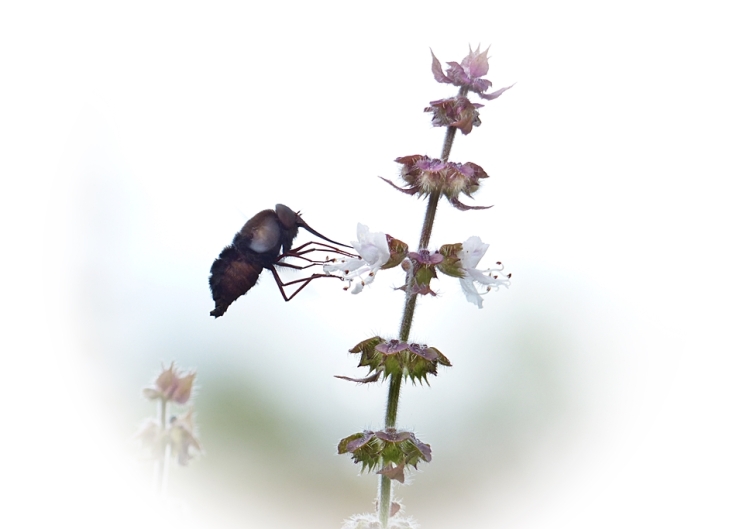
Sources: Picker, Mike, Griffiths, Charles & Weaving, Alan. 2019. Field Guide to Insects of South Africa. Cape Town: Struik Nature; Wikipedia. 2018. Nemestrinidae. https://en.wikipedia.org/w/index.php?title=Nemestrinidae&oldid=844643685
Posted by Carol






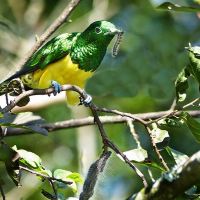
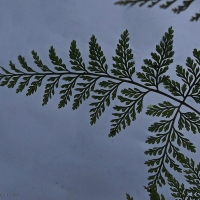
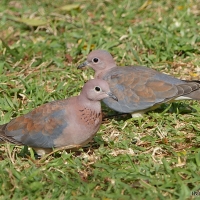
October 23, 2019 at 2:45 am
Fascinating, as always. Your photographic skills are quite amazing, too.
LikeLiked by 1 person
November 7, 2019 at 7:38 pm
Thanks Gunta.
LikeLike
October 12, 2019 at 11:03 am
These are stunning Carol! That is such a curious fly!
LikeLiked by 1 person
October 12, 2019 at 8:34 pm
Thanks so much Pete. The more I learn about flies, the curiouser and curiouser I discover them to be!
LikeLiked by 1 person
October 11, 2019 at 11:11 am
Being from the Western Cape, I will start to look out for the ones you mention. Thanks for lovely photos once more, Carol!
LikeLiked by 1 person
October 12, 2019 at 8:33 pm
Hi Suzette, and thanks. Yes some species in the Western Cape sound to be particularly fascinating and in fact are a keystone species. You might be interested to see an article on how some species of gladiolus and pelargonium in the Overberg are dependent on a specific long-tongued Tangle-veined Fly species for pollination, in an article titled “Cupid comes in many guises”, available at http://pza.sanbi.org/sites/default/files/info_library/cupid.pdf
LikeLike
October 11, 2019 at 10:41 am
Wonderful photographs – such patience!
LikeLiked by 1 person
October 12, 2019 at 8:19 pm
Thanks Sandra – as I mentioned in another comment, it is all so dynamic that it doesn’t feel like patience!
LikeLike
October 11, 2019 at 9:22 am
How much patience did it take, I wonder, to photograph these tangle-veined flies ? Remarkable
LikeLiked by 1 person
October 12, 2019 at 8:18 pm
You know it doesn’t feel like patience as things keep changing from moment to moment and opportunities are fleeting. To me sitting down and sewing something complex and demanding requires patience 🙂
LikeLiked by 1 person
October 11, 2019 at 5:52 am
They’re pretty fast, and you got them great! I often see in my garden the “großen Wollschweber“ (Bombylius major). I love these guys! 😊
LikeLiked by 1 person
October 11, 2019 at 5:34 am
Great photos, and now that I learn they could be confused with horseflies, I would have been giving them a wide berth! Which would have been a pity as they obviously repay close observation.
LikeLiked by 1 person
October 12, 2019 at 7:29 pm
Yes they are fascinating. I am just speculating re the confusion with horseflies. Despite the fact that my dad was an entomologist, I grew up assuming all insects that looked like long-tongued flies would be horseflies even though the behaviour of nectar feeders is completely different!
LikeLiked by 1 person
October 13, 2019 at 12:30 pm
Nectar definitely a better option than my blood!
LikeLiked by 1 person
October 11, 2019 at 3:05 am
I’ve never seen anything like that before. Very interesting how different creatures adapt to specific needs. These are great photos that open up a little window into their world.
LikeLiked by 1 person
October 13, 2019 at 12:52 pm
It is very interesting and the variations and the complex interrelationships between pollinators and plants are quite mind boggling.
LikeLiked by 1 person
October 11, 2019 at 2:53 am
Tricky to photograph but you did splendidly, Carol, and opened our eyes to yet another world of beauty in the process!
LikeLiked by 1 person
October 12, 2019 at 7:27 pm
Thanks Dries. Definitely is an eye-opening fly!
LikeLiked by 1 person
October 10, 2019 at 6:44 pm
I really need to look out for these – they must be around and I haven’t noticed them. Your photographs are wonderfully clear.
LikeLiked by 1 person
October 10, 2019 at 7:54 pm
Thank you Anne. I am not sure when I first started really noticing them as its may be possible to confuse them with horseflies at first. Even now I am aware of them, I don’t see them all that often – mostly in the autumn and winter months. I hope you get to see some around before too long.
LikeLike
October 10, 2019 at 5:11 pm
What an unusual adaptation. Must have a heck of a time on a windy day!
LikeLiked by 1 person
October 10, 2019 at 7:51 pm
Indeed re the wind 🙂 The adaptation is peculiar, and I understand that the species of Tangle-veined Flies in the Western Cape where the proboscis is especially long, co-evolved with a specific range of plants that they pollinate and the plants and the flies are mutually dependent on each other for their survival.
LikeLiked by 1 person